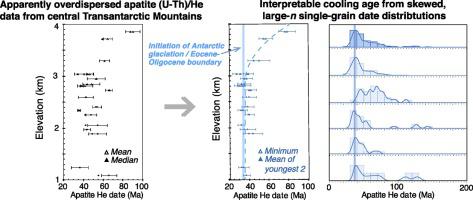Earth and Planetary Science Letters ( IF 4.8 ) Pub Date : 2021-05-27 , DOI: 10.1016/j.epsl.2021.117009 John He , Stuart N. Thomson , Peter W. Reiners , Sidney R. Hemming , Kathy J. Licht

|
Apatite (U-Th)/He thermochronology has the potential to reconstruct records of erosional exhumation that are critical to understanding interactions between climate, tectonics, and the cryosphere at high latitudes on million-year timescales. However this approach is often hindered by the problem of intrasample single-grain date dispersion. Here we present an extensive new apatite (U-Th)/He dataset (n = 361) from the central Transantarctic Mountains of East Antarctica between 160°E to 170°W and 84 to 86°S, and show that apparently uninterpretable data in most samples are a reflection of inadequate sampling of skewed date distributions. We outline a workflow for interpreting such dispersed data and demonstrate that geologically meaningful age interpretations are possible in the case of rapidly cooled samples, despite the wide array of potential causes for date dispersion. We show that for samples and compilations with a large number of single-grain analyses (n > ∼25), the youngest probability distribution peak represents the most likely time of fast cooling through the apatite (U-Th)/He closure temperature. When fewer grains are analyzed, the youngest peak is represented best by the minimum date or first quartile date, depending on sample size. Using this workflow, we show that since the latest Eocene, up to 8.8 km of exhumation occurred to incise the deepest point of the Beardmore Glacier trough. Rapid incision began at c. 37-34 Ma (at the latest by 34±3 Ma), coinciding with or slightly preceding the initiation of Antarctic glaciation at the Eocene-Oligocene transition, and contributed to at least 2.6 km of exhumation within the first 3-6 million years, at an apparent exhumation rate of no less than 0.4 mm/a.
中文翻译:

始新世-渐新世过渡期中南极中部山脉的快速侵蚀:来自Beardmore冰川的偏斜(U-Th)/ He日期分布的证据
磷灰石(U-Th)/ He热年代学有可能重建侵蚀性发掘的记录,这对于了解百万年尺度高纬度气候,构造学和冰冻圈之间的相互作用至关重要。但是,这种方法通常会受到样本内单粒数据分散的问题的阻碍。在这里,我们提出了一个新的广泛的磷灰石(U-Th)/ He数据集(n = 361),该数据集来自东极南极中部山脉,温度介于160°E至170°W和84-86°S之间,并显示了显然不可解释的数据。大多数样本都反映了偏斜日期分布的抽样不足。我们概述了用于解释此类分散数据的工作流程,并说明了在快速冷却的样品中,具有地质意义的年龄解释是可能的,尽管存在造成日期分散的各种潜在原因。我们表明,对于具有大量单颗粒分析(n>〜25)的样本和合集,最小的概率分布峰表示通过磷灰石(U-Th)/ He封闭温度快速冷却的最可能时间。当分析的谷物较少时,最短的峰最好用最小日期或第一个四分位数日期来表示,具体取决于样本量。使用此工作流程,我们表明,自最新的始新世以来,发生了长达8.8公里的掘尸,切下了Beardmore冰川槽的最深点。快速切开手术始于c。37-34 Ma(最晚为34±3 Ma),与始新世-渐新世过渡期间南极冰期开始时相吻合或稍早,并至少贡献了2。











































 京公网安备 11010802027423号
京公网安备 11010802027423号